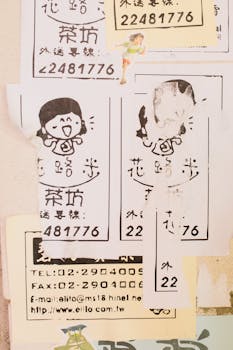Introduction
Welcome to the world of Chinese characters or Hanzi - the backbone of the Mandarin language and a captivating realm of visual symbolism and linguistic nuances. Unraveling the mystery of these characters can seem like a daunting task, but don't be intimidated. With the right strategies, understanding the structure, origin, and evolution of these characters and recognizing their usage frequency will soon become second nature.
In this comprehensive guide, we will delve deep into the heart of Chinese language learning, focusing on the essential aspect of mastering Hanzi. We will share insights into the fascinating history of Chinese characters, their structure, and how to differentiate between simplified and traditional characters. You'll learn effective strategies for memorizing characters, the importance of stroke order, and how technology, like learning apps, can aid your learning process.
This guide will be your companion in your quest to learn Chinese Hanzi, offering practical tips about incorporating characters into daily life and the role of calligraphy in learning. We'll also discuss how to progress from learning individual characters to understanding word formation, reading and writing sentences, and even exploring Chinese literature.
So, if you're a lifelong learner eager to unlock the secrets of Chinese characters and master Hanzi, this guide is just for you. Let's dive in!
Understanding the Basics of Chinese Characters (Hanzi)
Just as building blocks form the foundation of a sturdy structure, understanding the basics of Chinese characters, or Hanzi, is crucial for mastering Mandarin. These fundamentals include the origin and evolution of Hanzi, the distinction between Simplified and Traditional Chinese characters, the structure of Hanzi, and understanding the number of characters and their usage frequency. With this knowledge, you'll be well-equipped to delve into the intricate world of Chinese characters.
The Origin and Evolution of Chinese Characters
Chinese characters have a rich history dating back thousands of years. Originally, most characters were visual representations of physical elements like trees, houses, or humans. Over time, these symbols evolved into simplified versions known as character radicals, forming the foundation for contemporary written Mandarin. By understanding this evolution and the connection between characters and their physical representations, you can gain a deeper appreciation for Chinese characters and their logical structure.
Simplified vs Traditional Chinese Characters
In your Hanzi learning journey, you'll encounter two forms of Chinese characters: Simplified and Traditional. Traditional Chinese characters are the more ancient form, used for centuries in places like China, Taiwan, and Hong Kong. They are often more complex, consisting of more strokes and intricate details. Simplified Chinese characters, introduced in mid-20th century Mainland China to increase literacy, have fewer strokes and are easier to write. They are widely used in Mainland China, Singapore, and Malaysia.
The form you choose to learn largely depends on your learning goals and the region you're interested in. If you're planning to interact with communities in Taiwan or Hong Kong, Traditional Chinese would be more applicable. Meanwhile, Simplified Chinese would be the choice for those aiming to engage with Mainland China, Singapore, or Malaysia.
The Structure of Chinese Characters: Radicals and Strokes
At the heart of every Chinese character are radicals or "bushou". These are the crucial building blocks in Chinese characters, often providing a hint to the meaning or pronunciation of the character. For instance, the character "休" (to rest) is composed of the radicals "人" (person) and "木" (tree), suggesting a person resting under a tree. By learning the basic radicals, you'll start to see patterns and connections between characters, significantly aiding your memorization and understanding.
The Number of Chinese Characters and Their Usage Frequency
Most Chinese dictionaries include about 20,000 characters, though literate speakers are estimated to know between 5,000 and 8,000. As a language learner, being familiar with just 2,000 to 3,000 characters will give you the tools to read most newspapers and magazines. Remember, the key is not to feel overwhelmed by the number, but to focus on understanding the core structure of characters and their functional components.
Understanding the basics of Chinese characters is the first step in your journey to mastering Hanzi. In the next section, we'll delve deeper into effective strategies for learning Chinese characters, equipping you with the necessary knowledge and techniques to conquer Mandarin.

Strategies for Learning Chinese Characters
Now that you've grasped the basics of Chinese characters, let's dive into the strategies that can expedite your learning process. From understanding the importance of stroke order, using mnemonics for memorization, to setting realistic goals, and employing repetition, each strategy holds unique value in your journey to mastering Hanzi.
The Importance of Stroke Order
Learning Chinese characters might seem like a daunting task at first glance, but understanding the stroke order can significantly simplify this process. When writing Chinese characters, the order in which you draw the strokes is not arbitrary. Native speakers follow a specific order because it's practical, efficient, and gives the characters a balanced, natural look.
Learning correct stroke order not only enhances the aesthetics of your handwriting but also makes it easier to understand the handwriting of other people. In addition, it facilitates using handwriting input methods on digital devices. Without adhering to the correct stroke order, you risk creating more confusion and slowing down your learning progress.
Using Mnemonics and Storytelling for Memorizing Characters
Another potent strategy for learning Chinese characters is the use of mnemonics and storytelling. By associating characters with vivid images or memorable stories, you can strengthen your memory retention and recall.
For instance, consider the character '木' (mù), which means 'tree.' You could visualize it as a picture of a tree with branches spreading out in all four directions. This way, each time you encounter this character, the image of the tree springs to your mind, enhancing your recall.
Setting Realistic Goals for Character Learning
Setting realistic learning goals is another crucial aspect of mastering Chinese characters. While it might be tempting to aim for the stars and learn all 50,000 characters, it's essential to remember that even native speakers typically only use around 5,000.
Start with the most common characters, as they will provide the most significant return on your time investment. As your confidence grows, you can gradually expand your repertoire.
The Role of Repetition and Spaced Repetition in Learning Chinese Characters
The power of repetition in language learning cannot be overstated. By repeatedly reviewing new characters, you embed them into your long-term memory, transforming passive recognition into active recall.
To make your repetition more effective, consider using spaced repetition. This technique involves reviewing information at specific intervals, strategically revisiting harder-to-recall characters more frequently. Over time, this approach can enhance your ability to remember Chinese characters for a long duration.
By combining these strategies with the right tools like Traverse, you can make your Chinese learning journey not only more efficient but also more enjoyable. Remember, it's about acquiring and internalizing knowledge, not just consuming information.
Stay tuned for the next section where we'll discuss how you can leverage technology to aid your Hanzi learning journey.
Utilizing Technology to Learn Chinese Characters
Embrace the digital age in your Chinese character learning journey. As with any language, harnessing the right technology can significantly boost your learning experience, making it more efficient, dynamic, and enjoyable. In this section, we'll explore how learning apps, flashcard systems, and comprehensive online courses can help you master Chinese characters.
The Benefits of Using Learning Apps like Traverse
Understanding and memorizing Chinese characters may seem like a daunting task. However, with cutting-edge learning apps, this process becomes much more manageable and engaging.
Take, for instance, Traverse, an app that has revolutionized the way Mandarin learners approach Chinese characters. Traverse is not an ordinary flashcard app. It combines mind mapping, spaced repetition flashcards, and connected note-taking, providing a unique and comprehensive approach to learning. By visually mapping out the connections between different characters, you can understand their interrelations and build a more profound understanding of the Chinese writing system.
How to Import Anki Decks into Traverse for Continued Learning
For learners already familiar with Anki, a flashcard app based on the spaced repetition system, you'll be delighted to know that Traverse supports Anki deck imports. This function allows you to integrate your existing flashcards into the innovative system Traverse offers, combining your previous efforts with the new learning methods. The transition is seamless, ensuring no disruption to your learning progress.
Partnering with Mandarin Blueprint for Comprehensive Learning
For a more holistic approach to learning Mandarin, consider teaming up with Mandarin Blueprint. This online course focuses on character learning and immersive learning, providing a structured and comprehensive pathway to mastering Mandarin. By combining the use of a dynamic learning app like Traverse with the structured course material from Mandarin Blueprint, you can supercharge your learning and make mastering Chinese characters an achievable goal.
Remember, the key to mastering Chinese characters lies in using a combination of effective strategies, regular practice, and the right technological tools. With Traverse, Anki, and Mandarin Blueprint, you have a powerful arsenal at your disposal to unlock the secrets of Chinese characters. Up next, we'll delve into practical tips for enhancing your learning journey and boosting your memory retention of Chinese characters. Stay tuned!

Practical Tips for Mastering Chinese Characters
In the world of language learning, immersion is key. As we transition from the digital realm to the tangible world, let's explore how you can incorporate Chinese characters into your daily life, appreciate the beauty of calligraphy, and unlock the wisdom of Chinese proverbs and idioms.
Incorporating Chinese Characters into Daily Life
To truly master Chinese characters, make them a part of your daily routine. Label household items with their corresponding Chinese characters and read them aloud whenever you come across them. It's a simple, yet effective strategy to reinforce your memory and pronunciation.
Try reading Chinese texts that interest you – it could be news articles, blog posts, or even song lyrics. The more you expose yourself to real-world Chinese text, the more naturally you'll understand the context and usage of different characters.
The Role of Calligraphy in Learning Chinese Characters
Calligraphy, the art of writing, holds a significant place in Chinese culture. It's not only a form of artistic expression but also a meditative practice that helps you appreciate the beauty and structure of Chinese characters.
Practising calligraphy can boost your understanding of stroke order and character composition. As you slowly trace the strokes, you're essentially engraving the character in your mind. It's a perfect blend of art and learning that can enhance your memory retention and understanding of Chinese characters.
Learning Chinese Characters through Chinese Proverbs and Idioms
Chinese proverbs and idioms, often known as Chengyu, are a treasure trove of cultural wisdom and language learning. Each Chengyu is typically composed of four characters and carries a rich, historical story or moral lesson.
While it might seem daunting to learn these idioms, they offer a unique perspective into the Chinese way of thinking and the usage of characters. They also provide an excellent opportunity to learn characters in context, making them easier to remember.
As you get comfortable with basic characters, gradually introduce Chengyu into your learning routine. Not only will you be enriching your vocabulary, but you'll also gain insights into Chinese culture and history.
In the end, mastering Chinese characters requires a blend of systematic learning, repetition, and practical application. It's a marathon, not a sprint. So, take it one step at a time, and remember, every character you learn brings you one step closer to unlocking the secrets of the Chinese language.
Advanced Learning: From Characters to Words and Sentences
Having navigated the intricate world of Chinese characters, it's time to elevate our learning. With this foundation in place, we now move from individual characters to the formation of words and sentences. This advanced learning journey takes us beyond the fundamental building blocks, into the rich tapestry of meaning and context that truly brings the Chinese language to life.
Understanding Character Compounds and Word Formation
Chinese words are primarily formed through the combination of two or more characters known as compound characters. This process of word formation, while initially daunting, becomes remarkably intuitive with a clear understanding of each character's individual meaning.
For instance, the word 休息 ("xiūxí"), meaning "to rest", is a compound of the characters 休 ("xiū") and 息 ("xí"). Each character contributes to the meaning of the word, forming a vivid image of a person resting.
By identifying these character compounds and understanding their relationships, we can begin to deconstruct words, gaining a deeper understanding of their meanings and nuances. This approach not only enriches our vocabulary but also aids in the memorization and recall of words.
Reading and Writing Chinese Sentences
With a growing vocabulary, we can now progress to reading and writing Chinese sentences. Just like building a brick wall, constructing sentences involves arranging words in a particular order to convey a specific meaning.
In Chinese, the basic sentence structure is subject-verb-object (SVO). For example, in the sentence 我爱你 (Wǒ ài nǐ), "我" is the subject, "爱" is the verb, and "你" is the object. Understanding this fundamental structure is key to constructing and deciphering sentences in Chinese.
As you become more confident in constructing simple sentences, you can start to explore more complex sentence structures, including the use of conjunctions, prepositions, and modifiers.
Exploring Chinese Literature and Texts for Advanced Learning
As we move to the final stage of our journey, we dive into the world of Chinese literature and texts. Reading authentic Chinese materials such as newspapers, books, and online articles not only enhances your vocabulary and comprehension skills but also provides valuable cultural insights.
From the philosophical wisdom of Confucius to the modern prose of Mo Yan, Chinese literature offers a wealth of resources for advanced learners. Engaging with these texts allows you to encounter new vocabulary and complex sentence structures, immersing you in the language in a way that textbooks and flashcards can't.
In the grand scheme of things, mastering Chinese is not just about understanding a language. It's about opening a window to a vibrant culture, rich history, and a new way of seeing the world. Remember, every character, every word, and every sentence you learn brings you one step closer to fluency. So, here's to your journey in mastering Chinese characters. Keep going, and keep learning!
Conclusion
Recap of the Ultimate Guide to Mastering Chinese Characters
We've embarked on a remarkable exploration of the world of Chinese characters, or Hanzi, understanding their history, structure, and usage. We've dived into the deep pool of learning strategies, harnessing the power of stroke order, mnemonics, storytelling, and goal-setting to streamline our learning experience. We emphasized the vital role repetition plays, particularly the science-backed method of spaced repetition, in helping us retain these characters in our long-term memory.
Our journey led us to the digital realm, where we discovered the efficiency of learning apps like Traverse and the comprehensive course of Mandarin Blueprint. We've learned how to incorporate this new knowledge into our daily life and how calligraphy can serve as a creative and engaging way to practice Chinese characters. We've also touched on the beauty and wisdom encapsulated in Chinese proverbs and idioms.
Finally, we took our learning to the next level, exploring the fascinating process of word formation, and the art of reading and writing Chinese sentences. We've even dipped our toes into the vast ocean of Chinese literature, expanding our horizons and deepening our understanding of this beautiful language.
Encouragement for Continued Learning and Mastery of Chinese Characters
In the grand scheme of things, learning Chinese characters is more than just acquiring a new skill. It's an enriching journey that immerses you in a rich tapestry of culture, history, and thought. The road to mastery may seem challenging and long, but every step brings you closer to understanding and appreciating one of the world's oldest and most influential cultures.
As you continue, remember that the power of your progress lies in your hands. Stay consistent, review regularly, and don't shy away from making mistakes – they're an integral part of the learning process. Harness the tools and strategies we've discussed in this guide, and you'll see your progress in measurable strides.
The journey to mastering Chinese characters is an adventure. Embrace it with an open mind, curiosity, and the will to step out of your comfort zone. Each character you learn, each sentence you master, and every conversation you hold in Mandarin brings you one step closer to unlocking the secrets of this ancient and complex writing system.
You're on a path of discovery that will not only make you a proficient Mandarin speaker but also a global citizen with a deep appreciation for one of the world's most fascinating cultures. So, keep going, keep learning, and most importantly, keep enjoying the ride. Your journey to awesome Chinese begins here. With resources like Traverse, your Mandarin learning journey can be more effective, enjoyable, and rewarding. Here's to your success in mastering Chinese characters!

